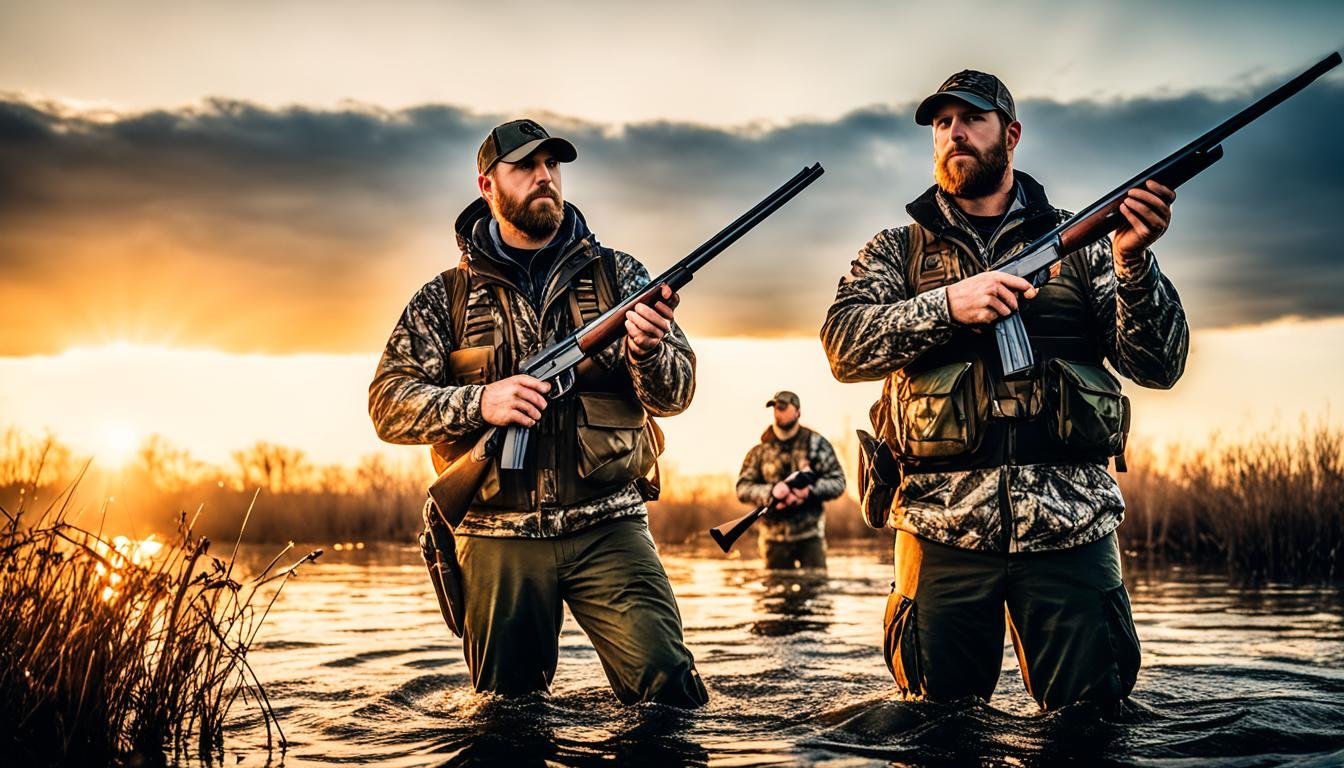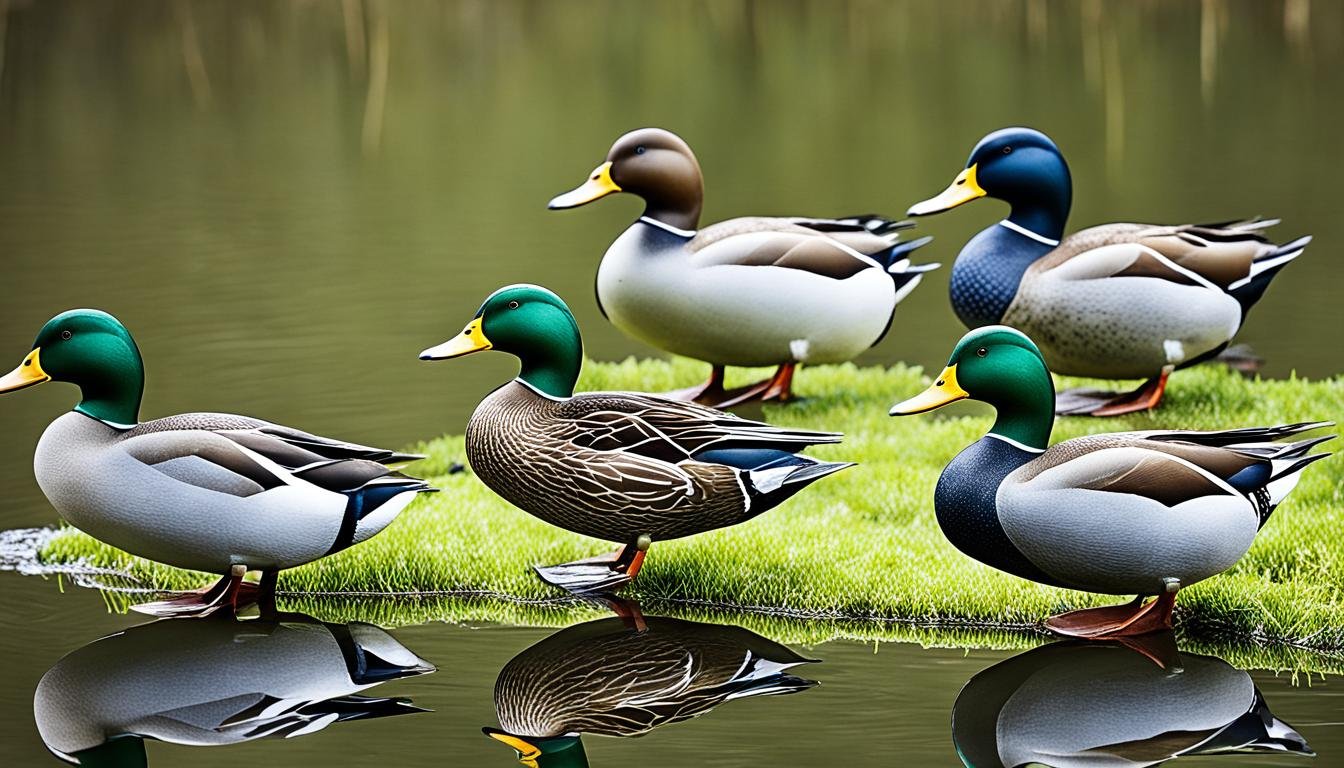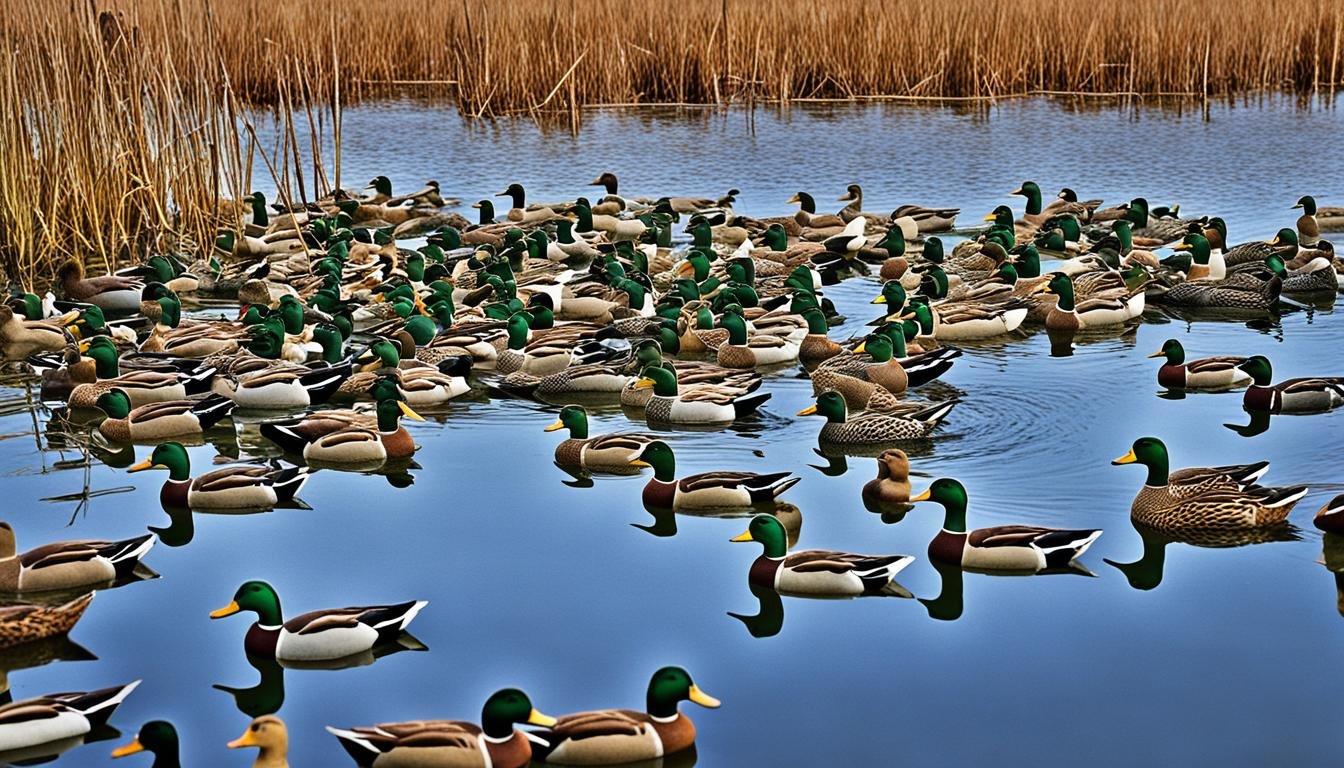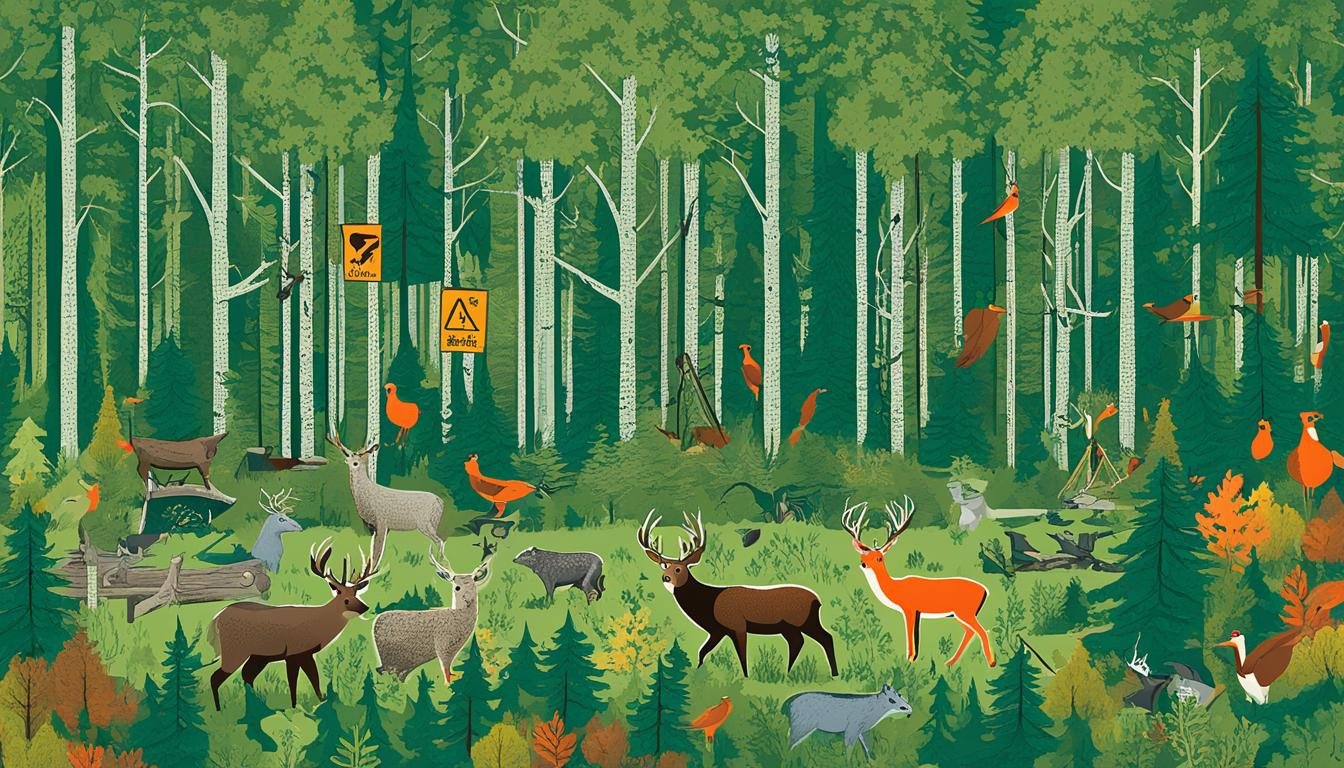Outfitters often handle four to six hunts daily.1 This high activity level demands top-notch skills and equipment for success. In this guide, we share advanced duck hunting strategies for the 2024 season.
In every hunt, it’s crucial to pattern your shotgun and set up your decoys just right. Picking the best spot for your blind and calling in a way that lures ducks are key. You’ll also learn to tell different duck species apart and follow flyway rules. Plus, we’ll help you boost your outdoor skills.
Key Takeaways
- It’s vital to pattern your shotgun for better shooting and more hunting hits.
- Creating a cut-through lane in your decoys helps direct birds your way.
- Handling blind shadows well keeps ducks calm and close.
- Adjust your calling to the ducks’ behavior to sound more natural.
- Bigger, natural-looking blinds can give you an edge in hiding.
Master the Art of Patterning Your Shotgun
Getting your shotgun pattern right makes sure you’re set for a good duck hunt. Duck hunting experts stress how key it is to shoot accurately. This is because your success depends on actually hitting those targets.2 For bird shooting, many pick 12-gauge shotguns. They like the modified and improved cylinder chokes. These chokes offer flexibility and a wider shot spread.2 Improving cylinder and modified chokes are top picks among hunters. Improved cylinder spreads the shot wider for short distances. Modified chokes make the pattern tighter for the mid-ranges.2
Hunt organizers often provide clay target throwers and boards for patterning. This lets hunters see how their guns and chokes work with different loads.2 Patterning your shotgun before hunting is vital. It ensures you can take down ducks cleanly. Different shotguns and chokes affect shells in unique ways.2 Shooting at clay targets also teaches aiming ahead of moving birds. This is called “lead.”2 Clay pigeon shooting mimics real hunting, honing your skills further.2
Veteran hunters should also pattern their guns. It helps find the best chokes and loads.2 Safety is crucial in hunting. Always treat your gun as if it’s loaded. Keep the muzzle in the safe direction. And stay alert about your environment and companions.2
Utilize the Cut-Through Lane for Efficient Decoy Setups
Adding a “cut-through” lane to your decoy spread can help lure in ducks and geese. By clearing a 25- to 30-foot path, birds can find a straight path to the heart of your decoys. This setup works well when the wind changes during your hunt. Such a tactic is like an “air traffic control” system, directing birds towards the core of your decoys which increases your shot success.
Manage Wind Shifts with Huntstand App
Handling wind shifts effectively can be done using Huntstand or similar apps. They forecast wind movements, aiding you in placing your decoys and blind strategically. This ensures birds are attracted to your area in the best way possible.
Create a Landing Strip for Incoming Birds
Placing decoys to make a landing strip is another good method.3 For example, Field Hudnall uses a decoy spread with various decoy types, including life-size Canada goose floaters. This spread imitates a natural landing place for the birds. It funnels the birds towards your shooting spots efficiently.
Eliminate Bird-Spooking Shadows from Your Blind
Layout blinds can work well for hunting, but they may make scary shadows.4 Close the door nearest to the sun first when shutting your blind. This way, the second door won’t cast a long shadow that might scare birds away.4 It’s also key to place your blind where it makes the smallest shadow on the ground.4 An A-frame blind should be faced into the sun to cut down on shadow size.4 Putting decoys where there’s more sunshine can attract ducks because they like brighter spots.4
Proper Blind Door Closing Technique
4 When shutting your blind, close the sun-side door first. This stops a huge shadow from forming and alarming birds.4
Positioning Your Blind for Optimal Sun Exposure
4 It’s crucial to pick a spot for your blind that keeps its shadow small. For A-frame blinds, direct them towards the sun to limit shadow size.4 Also, place decoys in sunny spots to attract ducks. They prefer sunny areas over shady ones.
Moderate Your Calling to Match Incoming Birds
Using duck and goose calls too much can hurt your hunting chances, especially with birds that are cautious.5 Hunters often don’t practice their calls enough in the off-season. And after getting some kills, they don’t push themselves to get better.5 Expert hunters suggest paying close attention to how loud and often birds call in, so you can do the same.5 If you’re too loud, you might scare the birds. If you’re too soft, it won’t sound real, and the birds won’t come close.5
Calling too much or too loudly can push ducks and geese away.5 An issue is overcalling, which makes birds fly off. Sometimes, being quiet or using gentle calls works better.5 Guides say it’s important to be moderate and respectful when your calls aren’t effective.5 Knowing when and how to change your calling can really boost your hunting skills.6
Duck Hunting Techniques: Go Big or Go Home
Big hunting blinds are great for hiding and looking natural to ducks.7 Experts who move blinds often like stand-up blinds, A-frames, and trailers that fit well with nature.7 They aim to blend in with the landscape, like rocks or trees in a field.7
Embrace Larger Blinds for Natural Concealment
Although these blinds might seem obvious to us, they make the ducks feel safe.7 When you’re looking for the best hunting spots, watch where the birds go and consider the weather.8 Placing a big, camouflaged blind in these good spots increases your chances.8
Leverage Prime Spotting Locations
8 If you’re aiming for ducks going from their sleep spots to eating areas, you can guess their moves. About half the ducks go straight to the fields, while others join up at water holes first.8 Focusing on these moving ducks, instead of where they sleep, helps keep their numbers up. And it keeps hunting good over time.8
Synchronize Your Shooting for Maximum Success
Coordination within a hunting party is key for success. Guides always say, if one hunter is faster, others may miss their shots. They might end up aiming at flying away birds.9 It’s best if everyone shoots together. This way, each person can aim at birds who are not aware.
Establish Shooting Lanes for Efficient Targeting
Setting up clear shooting lanes is very important. It makes sure no one aims at the same bird, which helps the group’s success. If someone shoots too quickly, ask them to wait. This helps the group work better together and hunt more effectively.

Decipher the Flyways for Optimal Season Timing
10 Ducks are different from other game because they travel across states. The federal government controls hunting ducks. This is because they move between four main areas in North America. They are the Pacific, Central, Mississippi, and Atlantic flyways.11 Each flyway has its own rules.
These rules include how many ducks you can shoot and when you can hunt. So,12 hunters must know the flyway they are in to follow the right rules.
Understanding the Four Flyway Zones
To hunt ducks legally,12 hunters need a federal duck stamp. They also need any state licenses and stamps required. Knowing the latest rules for your flyway and area is important for good hunting and being ethical.
Acquiring Necessary Licenses and Stamps
The guide talks about learning where ducks like to go and what they need.11 In Florida, hunters can also go to wildlife areas and stormwater treatment areas to hunt. But, there’s a limited number of spots, so hunters need to check the quota system.
Identify Diver and Puddle Ducks with Confidence
Ducks are split into two big categories: diver ducks and puddle ducks. Knowing what sets these groups apart, and being able to identify specific species, is key for duck identification. This ensures hunters follow the rules and hunt ethically.
Recognizing Diver Duck Species
Diver ducks eat plants and animals from under the water. Examples are Goldeneyes, Black Scoters, Canvasbacks13, and Hooded Mergansers. These birds fly off in a special way. They might need to run on water before they can take off.
Identifying Puddle Duck Species
Puddle ducks eat plants on the water’s surface. These ducks, like Mallards, Teals, Wigeons, Wood Ducks, Pintails, and Shovelers, are at ease on both land and water. In places like Texas and Mexico’s Laguna Madre, Redheads are very common, making them easy to spot for hunters13.
Getting to know the special looks and habits of these waterfowl species will prepare you for hunting. It also helps you follow the hunting laws.
Build Your Duck Hunting Gear Arsenal Strategically
Duck hunting can get pricey with gear costs adding up fast. Most of the gear needed for duck hunting is specialized and just for this activity. It’s important to carefully choose and build your duck hunting gear for successful and fun hunts.
Essential Waders, Jackets, and Gloves
The basics of your duck hunting gear include items to keep you warm, dry, and comfy. Waders are vital for moving through water and mud without wet feet. Quality hunting jackets and hunting gloves that are warm and waterproof are also key for comfort and focus.
Decoy Selection and Rigging
Choosing and setting up your decoys is critical in duck hunting gear. Opting for an all-coot decoy spread is a fresh strategy.14 Plus, using a mix of duck species in your decoys, like widgeon or spoonbills, sets your setup apart from the usual all-mallard look.14
Making homemade decoys using wood, cork, or old crab floats can also make your spread stand out.14
Calls and Lanyards for Effective Communication
Don’t forget quality hunting calls and hunting lanyards in your duck hunting gear. Using jerk cords with decoys adds lifelike motion, drawing in ducks.14 These aids help you talk to the ducks effectively, improving your hunt’s success.
Start your duck hunting gear with the essentials and grow from there. This method can greatly boost your hunting trips and wins. Remember, good duck hunting gear is a great field investment.

Select the Optimal Shotgun and Ammunition
Duck hunting often sees the 12-gauge shotgun as a favorite among hunters.15 It provides the power and flexibility needed to bag waterfowl. Most use pump-action or semi-automatic types with longer barrels. This helps deal with the kick from large duck loads.
12-Gauge Shotgun Recommendations
The top choice for auto-loading shotguns is the Beretta A390 Silver Mallard for duck hunting.15 Brands like Remington, Mossberg, and Weatherby are also highly regarded. They offer reliability and top-notch performance for hunters.
Non-Toxic Ammunition for Ethical Hunting
In waterfowl hunting, using non-toxic ammo is a must. This is because many places ban lead bullets to protect the environment.15 Brands like Hevi-Shot Tungsten, Federal Speed-Shok, and Winchester Drylok Super Steel provide great options in non-toxic. These choices not only follow the rules but also help keep hunting ethical and sustainable.
Choosing the right shotgun and ammo can greatly improve your duck hunting trips. It ensures you can hunt successfully and in an ethical way.15
Develop a Progressive Approach to Learning
Learning to hunt ducks well takes a step-by-step approach. Beginners should start by focusing on Mallards and Canada Geese16. These species are easy to spot, making them a great first lesson. Knowing these ducks and geese helps new hunters get a strong start.
Start with Mallards and Geese
Focusing on Mallards and Canada Geese at first is smart for new hunters. These ducks are common and stand out. Learning to hunt them well boosts a hunter’s confidence. It also sets the stage to go after more types of ducks later on.
Jump Shooting for Field Experience
For new hunters, jump shooting is a great way to learn. It means flushing ducks out from hiding near small bodies of water.16 This method helps beginners spot a range of duck types and learn about their habits. It’s a good start before moving on to other hunting methods.
Advance to Decoy Setups and Blinds
After mastering the basics, hunters can level up to using decoys and hiding in blinds.16 These strategies demand more skill and knowledge. Knowing duck behavior, handling the wind, and using calls are key. This gradual approach helps hunters grow step by step.
This way of learning is solid. It ensures hunters know their stuff before taking on harder challenges.16 Each skill learned leads to more enjoyable and successful hunts. It’s a path that builds confidence and expertise over time.
Conclusion
This guide has shared advanced17 duck hunting tips for the 2024 season. It covers everything from shotgun skills to effective decoy use. Hunters are given the knowledge to improve their17 waterfowl hunting.
Understanding17 duck species and flyway rules is key, along with ethical hunting. With these strategies, hunters can expect a great 2024 season.
The author, with 47 years of hunting, knows the sport well. They’ve seen trends change and still find success with old gear. This article offers a deep look into17 duck hunting today.
By following the author’s advice and using stats, hunters can plan for a successful, ethical17 2024. It promises to be a season of growth, no matter your experience level. This guide is full of insights to boost your17 duck hunting skills.
FAQ
How can I ensure accurate shotgun patterning for successful duck hunts?
What is the “cut-through” lane technique, and how can it improve my decoy setup?
How can I minimize the impact of blind shadows on incoming waterfowl?
How can I use calling effectively to communicate with waterfowl?
What are the benefits of using larger hunting blinds, and how can I optimize their concealment?
How can I ensure efficient coordination within my hunting party for maximum success?
What do I need to know about duck hunting regulations and flyways?
How can I effectively identify and distinguish between diver and puddle ducks?
What essential duck hunting gear should I invest in?
What shotgun and ammunition should I choose for duck hunting?
How can I develop a progressive approach to becoming a proficient duck hunter?
Source Links
- https://fabrand.com/blogs/articles/advanced-waterfowl-hunting-6-proven-guide-secrets
- https://www.findahunt.com/beyond-buckshot-advanced-shotgun-techniques-for-bird-hunting
- https://www.ducks.org/hunting/decoys/super-natural-spreads
- https://pursuitgo.com/2020/08/03/waterfowl-hunting-tips-six-hacks-for-hiding-your-layout-blind/
- https://www.wildfowlmag.com/editorial/why-you-suck-duck-goose-calling/472125
- https://dsgouterwear.com/blog/6-quick-tips-for-waterfowl-hunters/
- https://www.wildfowlmag.com/editorial/old-school-waterfowl-hunting-tactics-that-still-work-today/455084
- https://www.nodakoutdoors.com/threads/duck-hunting-field-tactics-tips.183917/
- https://www.ducks.org/hunting/goose-hunting-tips-tactics/the-ultimate-guide-to-hunting-canada-geese
- https://www.ducks.org/hunting/waterfowl-hunting-tips/warm-weather-duck-hunting-tips
- https://www.wildfowlmag.com/editorial/atlantic-flyway-history-opportunities/486876
- https://discover.texasrealfood.com/hunting-for-dummies/duck-hunting-tips
- https://www.wildfowlmag.com/editorial/complete-guide-diver-duck-hunting-diver-species/467179
- https://www.ducks.org/hunting/decoys/5-fantastic-duck-spreads
- https://www.outdoorlife.com/story/hunting/the-favorite-best-shotgun-choke-ammo-combinations-of-duck-hunters/
- https://realtree.com/waterfowl-hunting/articles/getting-real-duck-and-goose-hunting-goals
- https://projectupland.com/waterfowl-hunting-2/duck-hunting-tactics-for-low-action-states/








